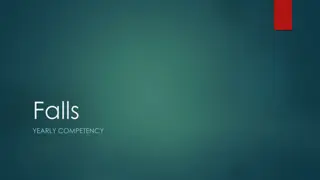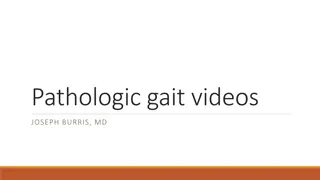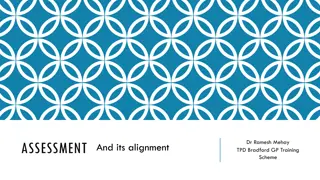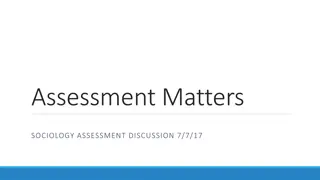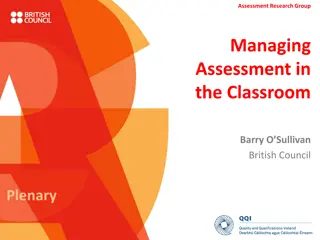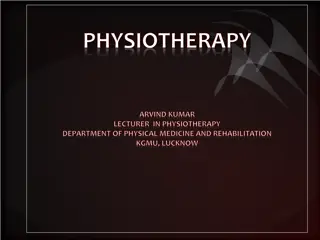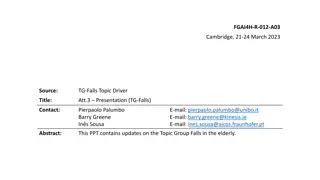Musculoskeletal System Assessment Guidelines
Learn how to conduct a thorough musculoskeletal system assessment, including functional assessments and physical examination guidelines. Explore assessment techniques for ADLs, gait observation, joint palpation, muscle strength testing, and more in nursing practice.
1 views • 17 slides
PHYSIOTHERAPY IN KNEE JOINT INJURIES
Explore the anatomy of the knee joint, common knee injuries like meniscus tears and ACL ruptures, and the role of physiotherapy in treatment and rehabilitation. Learn about exercises, gait training, and post-surgical care for knee injuries.
2 views • 12 slides
Sheffield Early Help Assessment Form Update and Integration with Extended Support Plan
Sheffield has introduced an updated Early Help Assessment form to streamline the assessment process within the Early Help System. This new form combines the Early Help Assessment with the Extended Support Plan, aligning various assessment tools and referral forms into one comprehensive document. The
5 views • 22 slides
Enhancing Language Learning Through Peer Assessment
Explore the benefits of peer assessment as a valuable tool for language learning, comparing it with self-assessment. Discover the components and challenges of self-assessment, along with the potential of peer assessment to improve accuracy and promote self-regulation. Gain insights into what peer as
3 views • 29 slides
Podiatrist's Role in Managing Foot Involvement in Rheumatic Diseases
Rheumatology encompasses over 200 conditions affecting the musculoskeletal system, with foot involvement being significant in conditions like RA and OA. Podiatrists play a crucial role in diagnosing, treating, and preventing foot problems associated with inflammatory arthritis, such as joint damage,
0 views • 20 slides
Overview of DSW End Point Assessment Team Leader Level 3
DSW End Point Assessment Team Leader Level 3 provides a clear understanding of the assessment process, ensuring individuals comprehend why and when it occurs, responsibilities involved, and how DSW supports them. It covers topics such as what End Point Assessment entails, assessment design and deliv
1 views • 18 slides
Comprehensive Overview of Morse Fall Scale and Its Application in Preventing Falls
Falls among hospitalized patients pose a significant risk, with 30-50% resulting in injuries. The Morse Fall Scale (MFS) is a widely used method to assess fall risk, comprising six variables with predictive validity. Factors such as history of falling, ambulatory aids, gait, and mental status are cr
0 views • 13 slides
Comprehensive Guide to Acute Knee Examination in Urgent Care
This detailed guide covers the essential components of the acute knee exam conducted in an urgent care setting by Dr. Gregory Jones, including chief complaints, anatomy, examination techniques, ligament assessments, practical aspects, and more. The examination process involves assessing functional l
1 views • 27 slides
Overview of Pathologic Gait Patterns for Clinical Reference
Explore a comprehensive collection of videos and images demonstrating various pathologic gait patterns exhibited in patients with different lower extremity weaknesses and neurological conditions. From steppage gait to Parkinsonian gait, each video provides a visual insight into the distinct characte
0 views • 19 slides
Understanding Assessment in Medical Education
Exploring the concepts of assessment in medical education, including defining assessment, types of assessment, reliability, validity, and aligning assessment methods with intended learning outcomes. The importance of constructive alignment and the impact of assessment on learning outcomes are also d
1 views • 12 slides
Assessment Matters in Sociology: Enhancing Learning Through Evaluation
Explore the significance of assessment in sociology education, focusing on key questions to evaluate current assessment procedures, review individual course assessments, and develop strategies to enhance student learning outcomes. Delve into the centrality of assessment in the learning process, with
1 views • 15 slides
Understanding Azoturia in Horses: Causes, Symptoms, and Treatment
Azoturia, also known as exertional rhabdomyolysis or tying-up syndrome, is a multifactorial myopathy that mainly affects draft horses. It is characterized by stiffness in gait, reluctance to move, lameness, and myoglobinuria. The disease typically occurs during exercise after a period of rest and ca
0 views • 14 slides
Appropriate Drug Prescribing in Older Adults: Balancing Harm and Cure
Understanding age-related changes in pharmacokinetics and pharmacodynamics is crucial for appropriate drug prescribing in older adults. Recognizing high-risk medications to avoid, understanding common drug interactions, and conducting regular drug list reviews are key components in providing safe an
1 views • 47 slides
Insights into Managing Assessment in the Classroom by Assessment Research Group
Explore the importance of standards and assessment in education through the lens of the Assessment Research Group. Gain valuable perspectives on curriculum delivery, understanding the assessment system, learner assumptions, task parameters, and more. Discover how language, structure, and agency play
2 views • 25 slides
Vocabulary Exploration Week 1: Words and Definitions
Dive into the world of vocabulary with Week 1's words and their meanings. Work with a partner to discuss terms like "swell," "aspect," "navigation," "submerge," "porthole," "anxiety," "cultural," "rampart," "tight-fisted," and "gait." Explore the nuances and applications of each word through engagin
0 views • 16 slides
Understanding Normal Pressure Hydrocephalus: Clinical Features and Diagnosis
Normal Pressure Hydrocephalus (NPH) is a condition characterized by the classic triad of dementia, urinary incontinence, and gait disturbance. Learn about the history, types, diagnostic studies, and presentation of NPH, along with differentiating it from other diseases. Discover the current standard
0 views • 30 slides
Enhancing Understanding through Assessment in Educational Design Workshop
Learn and collaborate on assessment practices in education design at the "Understanding by Design Assessment Focus" workshop. The agenda includes sessions on summative and formative assessment, feedback, reporting, and more. Engage in activities like generating questions, finding destination partner
1 views • 76 slides
Introduction to Physiotherapy: Modalities and Exercise Therapy
Physiotherapy, a branch of medical science, utilizes various modalities like electric current, heat/cold, water, and exercises for therapeutic treatment. It includes exercise therapy with active and passive movements, electrotherapy, thermotherapy, hydrotherapy, and massage. Active movements involve
4 views • 42 slides
Institutional Assessment Planning Workshop Feedback and Insights
Feedback and insights from a recent institutional assessment planning workshop led by Dr. Mark Nicholas at FSU S. Warren Conference Center & Inn. Participants provided feedback on the usefulness of the content, presenter knowledge, ability to develop assessment plans, post-training assessment knowle
1 views • 9 slides
Understanding Posture, Balance, and Gait Analysis in Human Movement
This resource delves into the static assessment of posture and balance, exploring the various inputs and control mechanisms involved in maintaining standing posture. It discusses the key factors influencing posture, such as visual, somatosensory, proprioceptive, and vestibular systems, along with mu
0 views • 51 slides
Comprehensive Guide to Neurological Examination in Dogs and Cats
Neurological examination in dogs and cats is crucial for diagnosing nervous system disorders. This guide covers the recording of history, general and detailed clinical examinations, examination of CSF, radiographic examination, EEG, and brain biopsy. It includes assessing history, mental state, move
0 views • 20 slides
Understanding Higher Education Assessment: The Complete Guide
Higher education assessment involves a systematic process of collecting, reviewing, and utilizing information to improve student learning and development. This guide covers the assessment cycle, learning outcomes, the mission behind assessment in higher education, what assessment is and is not, reas
1 views • 36 slides
Understanding Gait Abnormalities and Re-Education: A Comprehensive Analysis by Sally Kennedy
Sally Kennedy, a UK physiotherapist, explores gait abnormalities common in older individuals and those with neurological conditions. The content delves into the stages of the normal gait cycle, from initial contact to mid-swing, highlighting the importance of identifying and managing common gait pro
0 views • 21 slides
Understanding the Phases of Gait Cycle
Gait is a rhythmic motion of the lower extremities characterized by alternating propulsive and retropulsive movements. The Gait Cycle consists of Swing Phase and Stance Phase, each crucial for walking efficiency. Stance Phase is further divided into stages like Initial Contact, Loading Response, Mid
0 views • 20 slides
Pathological Differences in Hip Joint Variations: Abnormal Gait Analysis
Understanding pathological gait variations related to hip joint differences is crucial in gait analysis. Excessive sagittal, coronal, and transverse plane motions impact stance and swing phases, leading to deviations in gait patterns. Excess flexion, limited flexion, past retraction, excess adductio
0 views • 13 slides
Understanding Pathological Knee Variations in Gait Analysis
Explore different knee deviations in gait analysis, such as limited knee flexion, knee hyperextension, extensor thrust, and excess knee flexion. Learn how these deviations disrupt normal gait patterns, impact muscle demands, and affect shock absorption during various phases of the gait cycle.
1 views • 19 slides
Understanding Gift Assessment Process at University of Washington
The Gift Assessment Process at University of Washington involves applying a 5% assessment to select current-use gifts over $1,000 and under $5 million. This assessment supports the university's advancement efforts and institutional priorities by transferring 5% of eligible contributions to the Provo
1 views • 5 slides
Overview of Environmental Impact Assessment and Strategic Environmental Assessment Directives
Environmental Impact Assessment (EIA) and Strategic Environmental Assessment (SEA) play crucial roles in evaluating the impact of planned activities on the environment. This content delves into the concept, origins, development, and key elements of environmental assessment, discussing the legal fram
2 views • 35 slides
Institutional Assessment and Effectiveness Workshop Achievements at SUNY Oneonta
The Office of Institutional Assessment and Effectiveness at SUNY Oneonta has made significant progress in developing assessment protocols and processes, leading to a culture of assessment. This includes completing planning and assessment cycles, establishing objectives and procedures, and aligning u
1 views • 16 slides
Understanding Gait and Balance Assessment in Elderly
Balance in elderly individuals is essential to prevent falls and injuries. Disorders of balance can lead to difficulties in posture maintenance, walking, and dizziness. Neural components play a crucial role in postural control, involving sensory processes, central processing, and effector components
0 views • 59 slides
Rehab Post Total Knee Arthroplasty in Older Adults with a Focus on Balance
This presentation focuses on the impact of osteoarthritis in older adults, key components of rehabilitation post Total Knee Arthroplasty (TKA), falls risk, evidence-based balance improvement interventions, and the importance of supervision in rehab programs. It discusses the common locations and cau
0 views • 30 slides
Decoding the Dynamics of Walking: An In-depth Exploration
Walking is a fundamental yet complex phenomenon that plays a crucial role in our daily lives. Despite its significance, the science behind how we walk is often overlooked in education and healthcare. This article delves into the various aspects of walking, from muscle actions to gait analysis, shedd
0 views • 46 slides
Oregon Department of Education Assessment and Accountability Resources
Access important information on assessments, accountability, and reporting from the Oregon Department of Education. Find resources on updating assessment records, accessing student scores, and staying informed about assessment requirements for the 2023-24 academic year. Explore links for assessment
0 views • 55 slides
Oregon Department of Education - Assessment Resources and Updates
Explore the Assessment Record Updating Application (ARUA), Accountability Warehouse Extract (AWE), Secure Assessment Reports, and other important tools and information provided by the Oregon Department of Education for assessment data owners, analysts, and partners. Access links for assessment admin
0 views • 54 slides
Advances in Fall Risk Assessment and Management for Older Adults
This presentation delves into updates on the stratification tool for fall risk in community-dwelling older adults, emphasizing the importance of early intervention through opportunistic health visits. It discusses a decision tree model for assessing fall risk, highlighting the significance of histor
0 views • 12 slides
Gait Device Selection for Children with Lumbar Level Myelomeningocele
This presentation discusses the considerations and choices of gait devices for children with lumbar level myelomeningocele. It covers the specific needs of pediatric patients, benefits and drawbacks of various devices, funding requirements, and clinical application through case studies. The material
0 views • 31 slides
Understanding Genu Valgum: Causes, Symptoms, Diagnosis, and Treatment
Genu valgum, also known as knock knees, is characterized by inward angulation of the legs at the knee joint. This condition can arise from various factors such as rickets, growth imbalances, muscle weakness, injuries, and more. Symptoms include visual separation of the ankles, altered gait, and pote
0 views • 6 slides
Comprehensive Guide to Neurological Exams
This guide provides a detailed overview of neurological exams, focusing on components such as cognition, motor function, and cranial nerves. It covers essential aspects like mental status, reflexes, sensation, and gait assessment. The importance of thorough examination in primary care settings is em
0 views • 29 slides
Evaluation of Genetic Abnormalities in a 45-Year-Old Male with Gait Abnormalities
A 45-year-old male with gait abnormalities was referred for evaluation, with an unknown inheritance and deceased parents. His father had a history of ataxia and tremor. Using the GAIN scoring metric, the genomic content was assessed, including the presence of protein-coding genes, established TS gen
0 views • 24 slides
Comprehensive Study of Lower Limb Anatomy and Function
Explore the detailed anatomy of the gluteal region, posterior compartment of the thigh, blood vessels, nerves, and muscles of the lower limb. Learn about dermatomes, communication areas, muscle actions, Trendelenburg gait, and more. This educational resource is part of a pedorthic program of study f
0 views • 14 slides






